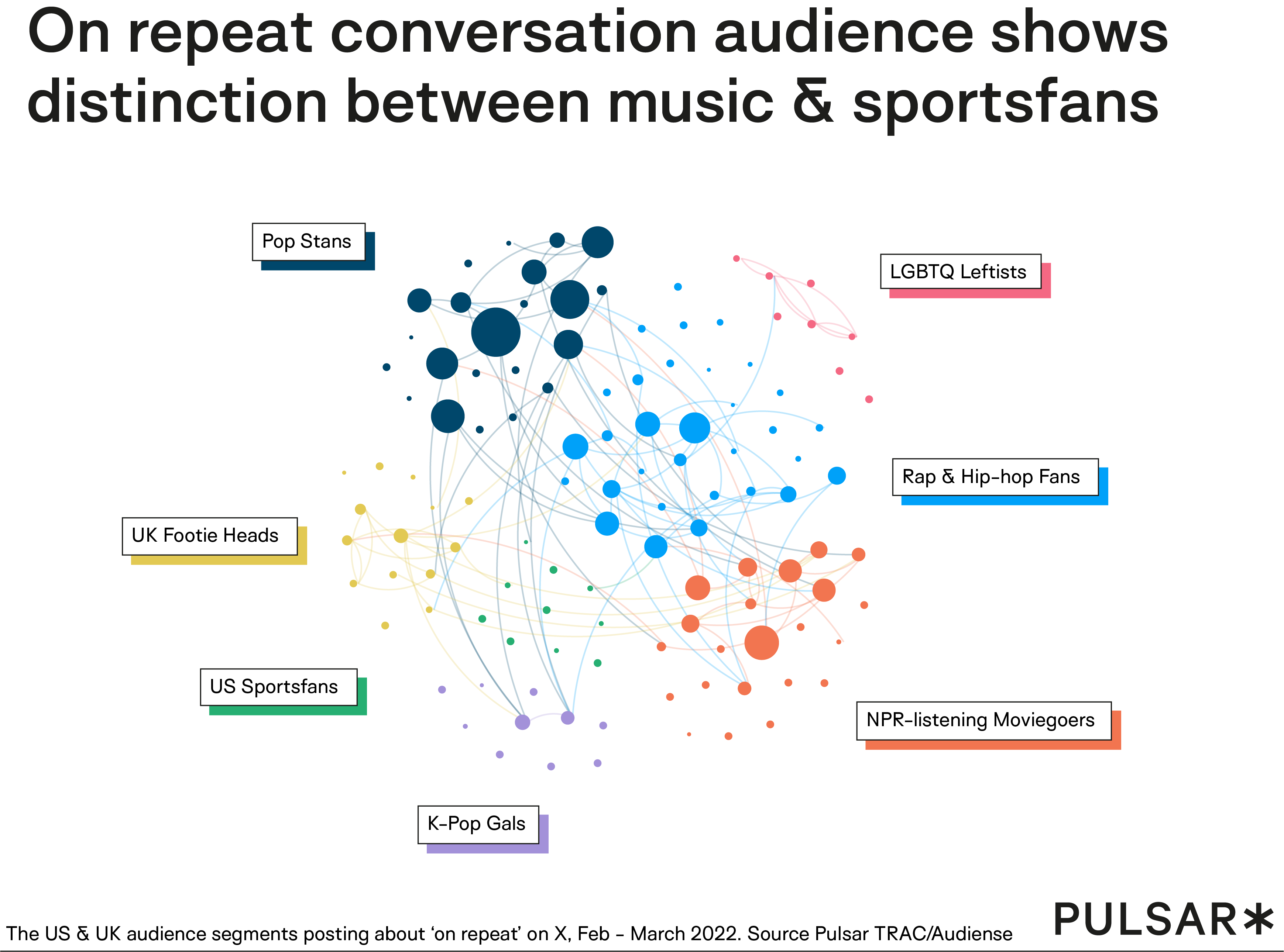
On repeat: the audiences behind the ultimate digital behavior
- Media & Entertainment
Media content on the Internet can be... so good. So good you want to experience it over and over. You consume your favorite media on repeat, on repeat, repeat, repeat. OK, you get the joke.
The concept of putting pleasant things on a loop isn't new in general, pre-dating the digital age. In days of yore you could loop tracks on some CD players (even tape decks with some analog wizardry), but experiencing things 'on repeat' is one of those native digital behaviors which has exploded over the past few years
And its growth has been steady over the past few years: Google search queries, which spiked during the pandemic, are on the rise, and so is audience interest on social media. There were only 561 tweets on Twitter in 2007 that used the phrase ‘on repeat’. Five years later, there were over 3.3 million, thanks to Spotify.
But is it just music that people are putting on repeat?
The first big question is how we consume that content: mostly with our eyes, or mostly with our ears?
Though ‘on repeat’ is a concept many would mostly link to song or playlist looping, we see around 40% of conversation about media consumption on repeat relating to video-based media.
With the rise of TikTok and other short-form media types that encourage repeat viewing with auto-looping, clips of sports, TV and games are taking up a sizable chunk of what previously was a much more hearing-oriented conversation.
However, when we crack open the shell on what people are viewing on repeat, we see that TikToks and short-form social media videos aren’t what people are talking about viewing on repeat.
People are turning to social media to talk about the TV and movies they’re watching ‘on repeat’ – sometimes used synonymously with ‘binge-watching’.
|
|
Though this is thought of as a separate behavior, it’s interesting to think about where binge-watching and ‘on repeat’ overlap. With ‘on repeat’, we see an additional idea where fans will consume their favorite shows ‘on repeat’ not only in full, but in clips, remixes and FMV (fan music videos).
watching this on repeat till new episode of house of the dragon comes out pic.twitter.com/zpeHAtQT0O
— Vasilisa (@vasilisonka) September 30, 2022
This repetitive behavior is sometimes talked about in conjunction with waiting for a new episode or series of a show to be released. This goes against the series-dumping streaming culture that Netflix and co have been betting on in recent years and indicates that, in a world where everything is at your fingertips, fans are relishing in the wait for their next episode.
With Disney’s streaming arm losing $887m in Q2 of 2022 and Netflix losing 1.2 million subscribers in the first six months of 2022, maybe the ‘on repeat’ audience hold the key to a growing movement in media consumption.
Perhaps 2023 could be the year that media creators find that audiences want to consume their favorite shows more slowly. Netflix may be following this idea by releasing the third series of its popular reality series Love is Blind in three installments in 2022.
Though audio-based ‘on repeat’ behavior is more prevalent, we can see that visual platforms are the stars of the show, gaining many more mentions than audio-based apps. (It’s worth noting that YouTube’s bar on Visual is the platform mentioned not in relation to music.) When it comes to music platforms, Spotify is the clear frontrunner - not surprising given its historical link to ‘on repeat’.
But which artists lend themselves to being thrown on repeat the most?
To anyone that’s spent even a small amount of time online, BTS coming in top as the artist most mentioned in relation to ‘on repeat’ is no surprise – the band owns 19 out of the top 30 most retweeted tweets of all time. Let’s look into the septet’s fanbase’s repetitive behavior.
Until PJM1 next year With You is probably the only song I'll listen to on repeat oh and don't forget to stream all other JIMIN JIMIN songs
Keep listening to #WithYou by #JIMIN #BTSJIMIN of #BTS (@BTS_twt) and Sungwoon
— 묘묘♡·͜·♡지민아 (@sowoozoolove) November 3, 2022
A lot of repeating media behavior is associated with the concept of ‘stanning’. A stan, said to have originated from the Eminem track ‘Stan’ in which a crazed fan dedicates their life to the artist, is a super fan of a celebrity, usually a pop artist.
Fanbases with strong stanning tendencies will often have unique monikers: BTS’s ‘Army’, Taylor Swift’s ‘Swifties’ and Beyonce’s ‘Beyhive’.
This stan behavior doesn’t just include listening to their favorite artist’s tracks on repeat, but it involves urging others to follow suit via social media, as well as using repeated words and hashtags in an attempt to get their favorite artist trending.
Taylor, please tell all the #Swifties who can’t come to your concert because they are being tortured by #LongCovid that they can attend this free online conference where world experts will discuss what the research is doing so they can go to your concerts again. @U2Fight_World pic.twitter.com/t9aNgpYtHk
— Fe. (@NoHealthNoFun) April 5, 2024
But does stanning allow artists to make more money? Though definitive sales statistics are hard to find, monthly active Spotify listeners are a great indicator of an artist’s commercial success. Let’s map ‘on repeat’ behaviors mentioned online alongside monthly Spotify listeners.
The short answer is: no. There seems to be no correlation between repetitive stanning behaviors and Spotify performance, indicating that ‘on repeat’ audiences aren’t necessarily putting their streams and cash where their tweets are.

When we take a snapshot of the ‘on repeat’ audience, we see a clear grouping of sub-audiences by music genres and sports - we also see two socio-politically-oriented outliers in NPR-listening Moviegoers and LGBTQ Leftists.
These audiences demonstrate a difference in their relationship to the digital ‘on repeat’ behavior in their physical lives as well. NPR Moviegoers are the most likely to be ‘on repeat’ whilst studying, while US Sportsfans and Rap & Hiphop fans enjoy getting repetitious at the gym.
Which brings us to something entirely unexpected that appeared in analyzing this Pulsar TRAC search. A key phrase popping up: “history on repeat”.
‘On repeat’ brought out more conversation about history and history ‘being on repeat’ than it did Spotify, Disney and Netflix combined. Conversation here covers topics such as war, the cost of living crisis and tumultuous politics.
Against a backdrop of burgeoning industrialization, Danish philosopher Søren Kierkegaard stated that “repetition and recollection are the same movement, except in opposite directions, for what is recollected has been, is repeated backward. Repetition, therefore, if it is possible makes a person happy, whereas recollection makes him unhappy.”
Okay… a bit deep. But consuming media ‘on repeat’ is one way of escaping experiencing the state of current affairs, a way of taking control over one’s psyche.
when i had to go on a plane this summer and had flight anxiety i listened to chilly on repeat to calm down and kept replaying this part
— mariah (@304sahi) November 3, 2022
So we put this to the test. Whilst listening to this piece, we listened exclusively to Taylor Swift’s recent single Anti-Hero. On repeat. Again and again. And how has it impacted us? We must admit, there’s something about the repeated lyrics, beats and melodies that lets you get into the groove with writing. Perhaps we chose the wrong song to get on repeat – but we’re not feeling soothed. In fact, we’re closer to feeling irritated. Or maybe we’re just the anti-hero.


